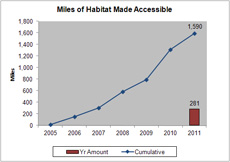forum
library
tutorial
contact

BiOp Plaintiffs say Implementation Way Behind Schedule
by Bill RudolphNW Fishletter, November 12, 2012
|
the film forum library tutorial contact |

|
BiOp Plaintiffs say Implementation Way Behind Scheduleby Bill RudolphNW Fishletter, November 12, 2012 |
 Action agencies recently filed their annual report on their progress in implementing the 2008/2010 hydro BiOp, and soon after, fishing and conservation groups involved in the litigation filed their annual complaint that progress has been too slow.
Action agencies recently filed their annual report on their progress in implementing the 2008/2010 hydro BiOp, and soon after, fishing and conservation groups involved in the litigation filed their annual complaint that progress has been too slow.
Though the environmental groups won the fight in court, U.S. District Judge James Redden gave the feds two years to keep the current plan in place, and told them to add more specific actions to help fish in an amended BiOp to be completed by the end of 2013.
The agencies' report details implementation during calendar year 2011, but the plaintiff enviro groups say it "lightly word-processes" the 2010 report. While updating generic tables from the earlier report, they said it fails to "illuminate" whether specific actions called for in the BiOp's "Reasonable, Prudent Alternative" (RPA) are being implemented "as anticipated," and whether survival improvements from actions are really adding up, and what is being done if there are any shortfalls.
Plaintiffs say there is considerable evidence in the report that implementation of estuary and tributary actions are not on track, that avian predation is increasing, steelhead improvements from kelt (fish that return to spawn more than once) conditioning are still hypothetical, and overall, RPA measures "have failed to generate the very large survival improvements on which the 2008 BiOp jeopardy analysis depends." The plaintiffs neglect to mention that avian predation has little effect on upriver fish populations from the Snake Basin compared to fall chinook released from hatcheries below Bonneville Dam.
Enviros say the 2010 status reviews and the latest comprehensive analysis of salmon survival by federal, state and tribal scientists indicates "little or no increase in salmon survival rates--and many declines--yet there are no plans to change dam operations or take any other steps to keep the species' chances of survival and recovery from declining even further." The "latest" analysis they refer to is the 2012 draft Comparative Survival Study from the Fish Passage Center.
The fishing and conservation groups also criticize the 2011 implementation report for "saying very little" about the Court-ordered spill regime in place since 2005, and not mentioning "the most recent scientific analysis" that concludes spill should be sharply increased to improve juvenile survival.
They cite the recent draft CSS report for that analysis, but fail to mention that the analysis on which those conclusions are based has never been vetted by the region, though published in a peer-reviewed journal sponsored by the American Fisheries Society.
Critics of the CSS spill analyses say it is based on spurious correlations, and if data from the 2001 migration year was excluded (when juvenile survival was extremely low and spill was nil), the conclusions from the analysis would not hold up.
Northwest RiverPartners, a group of BPA customers and other river users, filed comments noting that juvenile survival does not always benefit from higher flows and spill. NRP said 2011 was a case in point, where juvenile survival was lower than the previous two years, despite the fourth-best water conditions since 1960. Survival in 2012 was the second highest on record, despite an early pattern of high flows that peaked in April. "All this suggests that demands for more flow and spill are not the answer and must be approached carefully," said the NRP filing.
The NRP also pointed out that the court-ordered spill regime had resulted in lower fish survival and fewer returning adults because the added spill meant fewer fish were barged.
They also said 2011 performance testing at three projects had shown that standards for downstream juvenile survival were met or exceeded at the three projects by steelhead, and at two out of the three for spring chinook. "These results clearly show that the hydropower system is no longer a critical survival bottleneck and that the population of salmon and steelhead is increasing in the system."
Their comments also included a call for addressing a large policy gap in the all-H approach, the need for looking more at harvest issues, one of the 4-Hs, which also include hydro, habitat and hatcheries.
The state of Oregon and the Nez Perce Tribe--other plaintiffs in the BiOp litigation--also filed comments on the 2011 implementation plan. The Oregon filing hammered the federal report for not giving spill at dams any credit for improved juvenile survival in 2011.
The Nez Perce said the report left out any mention of specific dam operations advocated by the Tribe and other parties that were not implemented. They were critical of the performance testing completed by the Corps of Engineers to measure juvenile survival at some of the projects.
The Tribe also griped about having its projects cut 10 to 15 percent to help BPA balance its F&W budget this year, and chided the feds for not yet completing consultation that would lead to construction of the northeast Oregon hatchery program.
Related Sites:
2011 FCRPS BiOp Report
2012 draft Comparative Survival Study
learn more on topics covered in the film
see the video
read the script
learn the songs
discussion forum
